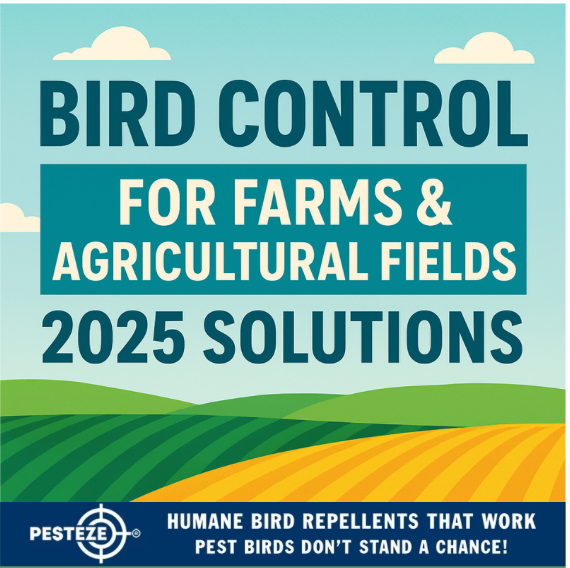BIRD CONTROL FOR FARMS & AGRICULTURAL FIELDS: 2025 SOLUTIONS FOR MAXIMUM CROP PROTECTION

BIRD CONTROL FOR FARMS & AGRICULTURAL FIELDS: 2025 SOLUTIONS FOR MAXIMUM CROP PROTECTION
SUMMARY
Birds can cause massive crop losses and damage in agricultural fields, leading to reduced yields and higher operating costs. This 2025 farmer’s guide highlights the latest eco-friendly, cost-effective, and scalable bird control strategies tailored to protect farms and fields from pest bird activity without harming the environment.
FEATURES
-
Modern Solutions: Up-to-date bird control strategies designed for 2025 challenges.
-
Eco-Friendly Practices: Non-toxic, wildlife-safe deterrents.
-
Cost-Effective Tools: Affordable methods that provide long-term savings.
-
Farm-Scale Ready: Adaptable for both small family farms and large agricultural operations.
-
Crop-Specific Tips: Strategies to protect fruits, grains, vegetables, and vineyards.
-
Seasonal Adjustments: Year-round solutions for migratory and resident bird species.
GUIDE DESCRIPTION
Farmers have long struggled with the challenge of keeping birds away from their crops. From starlings feasting on grapes to sparrows damaging grain, birds can reduce yields by up to 20% annually if left uncontrolled. In 2025, farmers now have access to a wider range of safe, effective bird control solutions that balance productivity with sustainability.
The first step in protecting agricultural fields is prevention through visual and sound deterrents. Reflective bird tape, holographic streamers, and predator decoys such as owls and hawks remain inexpensive and reliable first lines of defense. Paired with acoustic deterrents like ultrasonic devices or bio-acoustic calls that mimic predator sounds, farmers can create a multi-sensory environment that discourages birds from settling.
For larger farms, netting systems continue to be the gold standard for protecting high-value crops such as berries, vineyards, and orchards. Advances in lightweight, UV-resistant netting make these solutions easier to install and more durable against weather conditions. In grain fields, laser bird deterrents have gained popularity, particularly during early mornings and evenings when birds are most active.
Sustainability is key in 2025. Farmers are moving away from harmful chemicals and adopting eco-friendly repellentsmade from natural oils like peppermint or grape extract, which safely deter birds without harming crops or wildlife. These repellents can be applied via spraying equipment and integrated into standard crop maintenance routines.
Water sources and food waste around farms are major bird attractors. Ensuring proper waste management and sealing grain storage areas are critical steps in long-term bird control. Many farms also install drone-based patrol systems, which autonomously scare birds from fields throughout the day, reducing the need for constant human oversight.
Seasonal planning remains vital. Migratory species may only affect crops at certain times of year, while resident birds require continuous management. Farmers who regularly inspect their fields, rotate deterrent types, and combine multiple methods achieve the most reliable protection.
By following this 2025 farmer’s guide, agricultural producers can safeguard their crops, reduce losses, and maintain a bird-free environment—while respecting ecological balance and supporting sustainable farming practices.
- Pukhraj Sharma


Comments 0